Design-Build vs Traditional Procurement in Project Delivery Systems
VerifiedAdded on 2023/06/13
|35
|10048
|348
Report
AI Summary
This report provides an overview of construction project delivery systems, focusing on the differences between the traditional design-bid-build approach and the design-build system. It discusses various alternative delivery systems, including Indefinite Delivery/Indefinite Quantity (ID/IQ), Agency-Construction Manager (Agency-CM), Construction Manager at Risk (CM at-Risk), and the Portland Method. The report highlights the advantages and disadvantages of each system, emphasizing the benefits of design-build in terms of time savings, risk transfer, and innovation. It also touches on procurement practices, the role of construction managers, and the importance of integrated services in improving project efficiency and effectiveness. The document concludes by underscoring the shift towards more collaborative and integrated approaches in the construction industry.
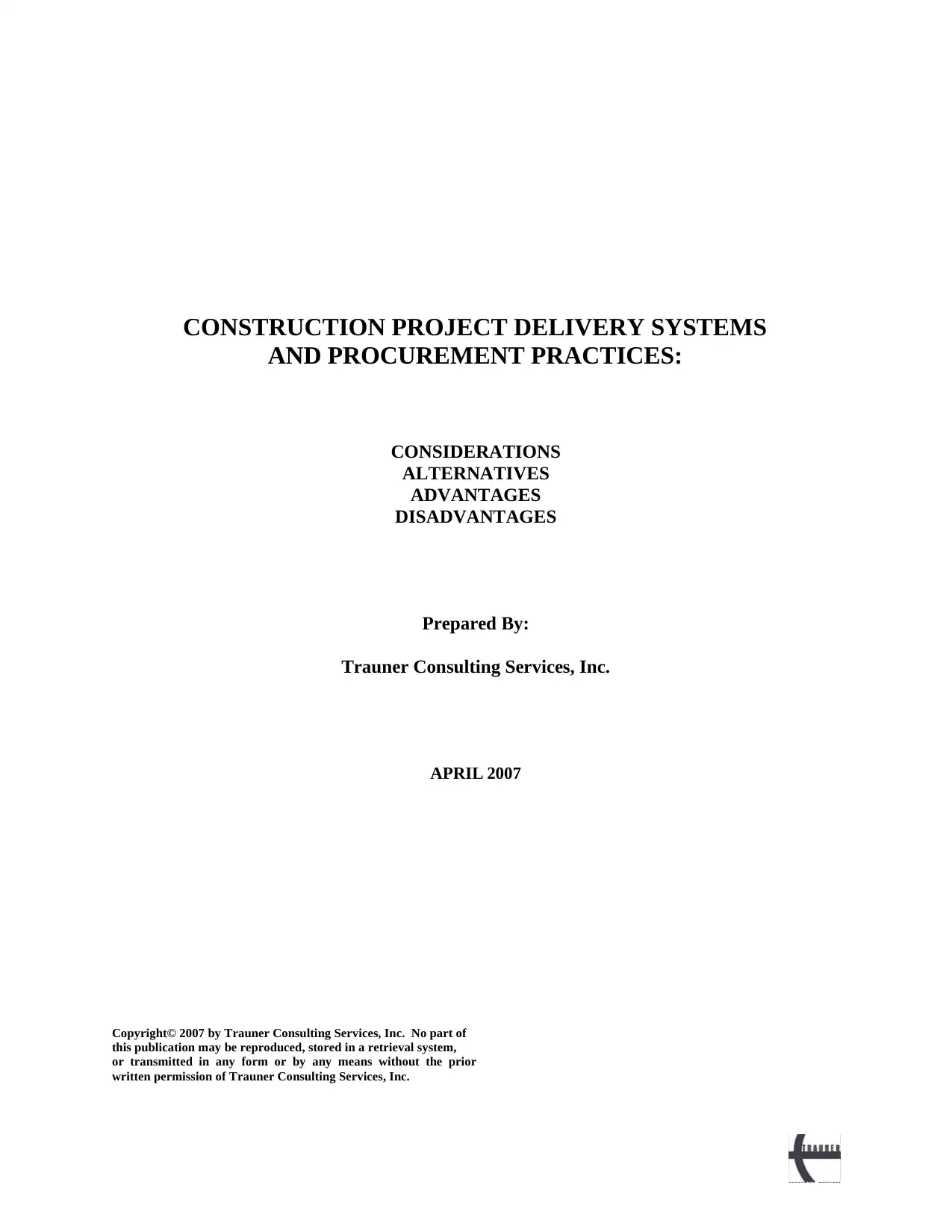
CONSTRUCTION PROJECT DELIVERY SYSTEMS
AND PROCUREMENT PRACTICES:
CONSIDERATIONS
ALTERNATIVES
ADVANTAGES
DISADVANTAGES
Prepared By:
Trauner Consulting Services, Inc.
APRIL 2007
Copyright© 2007 by Trauner Consulting Services, Inc. No part of
this publication may be reproduced, stored in a retrieval system,
or transmitted in any form or by any means without the prior
written permission of Trauner Consulting Services, Inc.
AND PROCUREMENT PRACTICES:
CONSIDERATIONS
ALTERNATIVES
ADVANTAGES
DISADVANTAGES
Prepared By:
Trauner Consulting Services, Inc.
APRIL 2007
Copyright© 2007 by Trauner Consulting Services, Inc. No part of
this publication may be reproduced, stored in a retrieval system,
or transmitted in any form or by any means without the prior
written permission of Trauner Consulting Services, Inc.
Paraphrase This Document
Need a fresh take? Get an instant paraphrase of this document with our AI Paraphraser
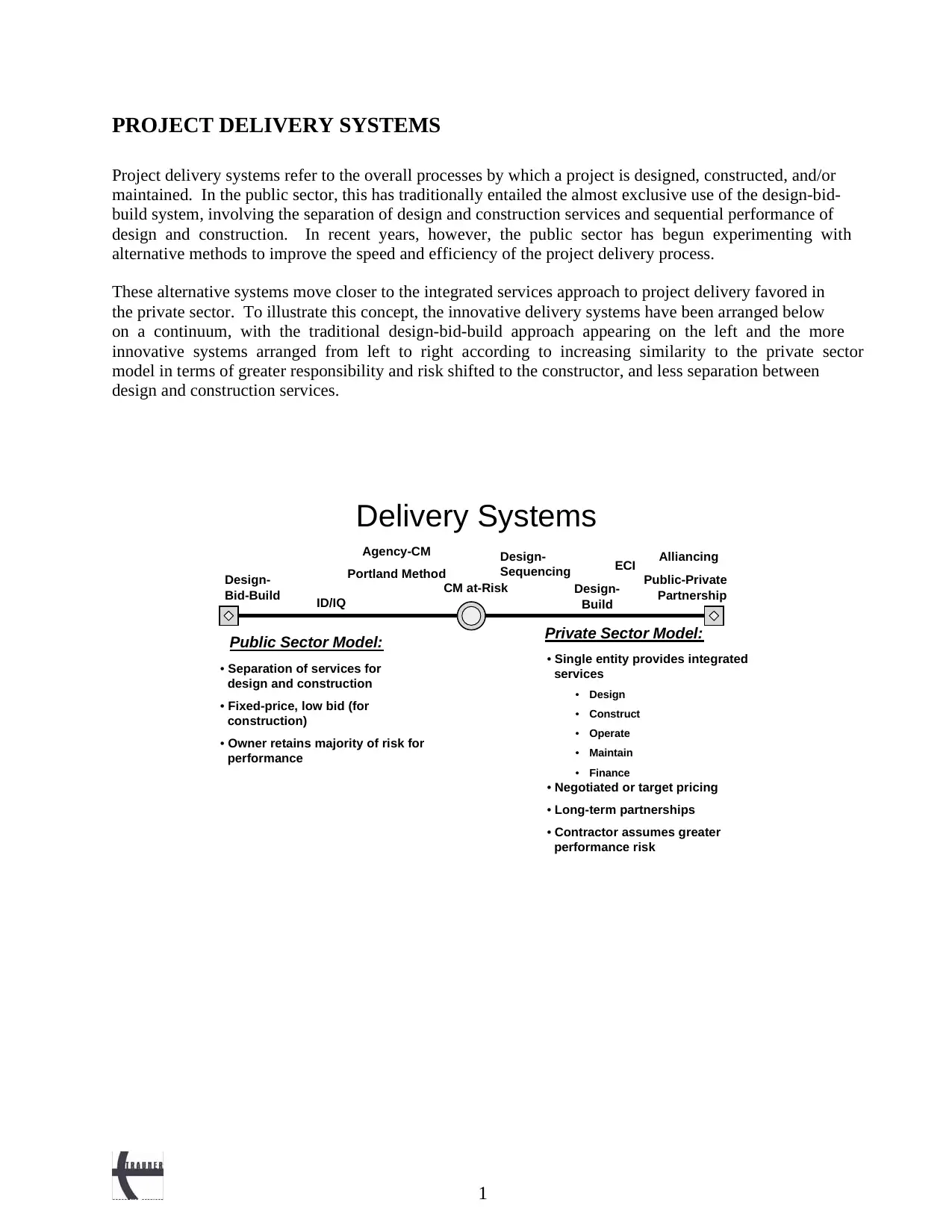
PROJECT DELIVERY SYSTEMS
Project delivery systems refer to the overall processes by which a project is designed, constructed, and/or
maintained. In the public sector, this has traditionally entailed the almost exclusive use of the design-bid-
build system, involving the separation of design and construction services and sequential performance of
design and construction. In recent years, however, the public sector has begun experimenting with
alternative methods to improve the speed and efficiency of the project delivery process.
These alternative systems move closer to the integrated services approach to project delivery favored in
the private sector. To illustrate this concept, the innovative delivery systems have been arranged below
on a continuum, with the traditional design-bid-build approach appearing on the left and the more
innovative systems arranged from left to right according to increasing similarity to the private sector
model in terms of greater responsibility and risk shifted to the constructor, and less separation between
design and construction services.
Design-
Bid-Build
Public-Private
Partnership
CM at-Risk
ID/IQ
Design-
Build
Public Sector Model: Private Sector Model:
• Separation of services for
design and construction
• Fixed-price, low bid (for
construction)
• Owner retains majority of risk for
performance
• Single entity provides integrated
services
• Design
• Construct
• Operate
• Maintain
• Finance
• Negotiated or target pricing
• Long-term partnerships
• Contractor assumes greater
performance risk
Delivery Systems
AlliancingDesign-
Sequencing
Agency-CM
Portland Method ECI
1
Project delivery systems refer to the overall processes by which a project is designed, constructed, and/or
maintained. In the public sector, this has traditionally entailed the almost exclusive use of the design-bid-
build system, involving the separation of design and construction services and sequential performance of
design and construction. In recent years, however, the public sector has begun experimenting with
alternative methods to improve the speed and efficiency of the project delivery process.
These alternative systems move closer to the integrated services approach to project delivery favored in
the private sector. To illustrate this concept, the innovative delivery systems have been arranged below
on a continuum, with the traditional design-bid-build approach appearing on the left and the more
innovative systems arranged from left to right according to increasing similarity to the private sector
model in terms of greater responsibility and risk shifted to the constructor, and less separation between
design and construction services.
Design-
Bid-Build
Public-Private
Partnership
CM at-Risk
ID/IQ
Design-
Build
Public Sector Model: Private Sector Model:
• Separation of services for
design and construction
• Fixed-price, low bid (for
construction)
• Owner retains majority of risk for
performance
• Single entity provides integrated
services
• Design
• Construct
• Operate
• Maintain
• Finance
• Negotiated or target pricing
• Long-term partnerships
• Contractor assumes greater
performance risk
Delivery Systems
AlliancingDesign-
Sequencing
Agency-CM
Portland Method ECI
1
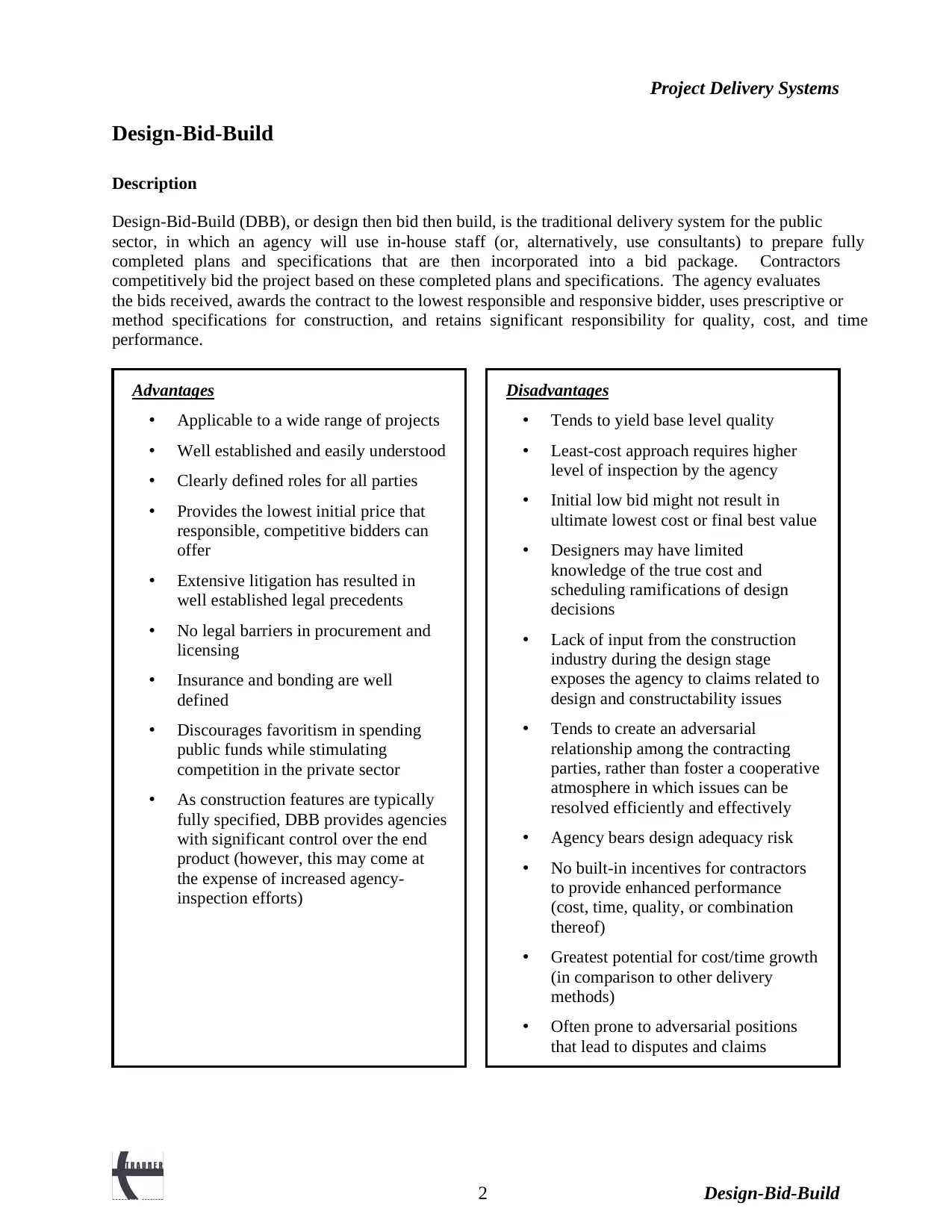
Project Delivery Systems
Design-Bid-Build
Description
Design-Bid-Build (DBB), or design then bid then build, is the traditional delivery system for the public
sector, in which an agency will use in-house staff (or, alternatively, use consultants) to prepare fully
completed plans and specifications that are then incorporated into a bid package. Contractors
competitively bid the project based on these completed plans and specifications. The agency evaluates
the bids received, awards the contract to the lowest responsible and responsive bidder, uses prescriptive or
method specifications for construction, and retains significant responsibility for quality, cost, and time
performance.
Advantages Disadvantages
• Applicable to a wide range of projects
• Well established and easily understood
• Clearly defined roles for all parties
• Provides the lowest initial price that
responsible, competitive bidders can
offer
• Extensive litigation has resulted in
well established legal precedents
• No legal barriers in procurement and
licensing
• Insurance and bonding are well
defined
• Discourages favoritism in spending
public funds while stimulating
competition in the private sector
• As construction features are typically
fully specified, DBB provides agencies
with significant control over the end
product (however, this may come at
the expense of increased agency-
inspection efforts)
• Tends to yield base level quality
• Least-cost approach requires higher
level of inspection by the agency
• Initial low bid might not result in
ultimate lowest cost or final best value
• Designers may have limited
knowledge of the true cost and
scheduling ramifications of design
decisions
• Lack of input from the construction
industry during the design stage
exposes the agency to claims related to
design and constructability issues
• Tends to create an adversarial
relationship among the contracting
parties, rather than foster a cooperative
atmosphere in which issues can be
resolved efficiently and effectively
• Agency bears design adequacy risk
• No built-in incentives for contractors
to provide enhanced performance
(cost, time, quality, or combination
thereof)
• Greatest potential for cost/time growth
(in comparison to other delivery
methods)
• Often prone to adversarial positions
that lead to disputes and claims
2 Design-Bid-Build
Design-Bid-Build
Description
Design-Bid-Build (DBB), or design then bid then build, is the traditional delivery system for the public
sector, in which an agency will use in-house staff (or, alternatively, use consultants) to prepare fully
completed plans and specifications that are then incorporated into a bid package. Contractors
competitively bid the project based on these completed plans and specifications. The agency evaluates
the bids received, awards the contract to the lowest responsible and responsive bidder, uses prescriptive or
method specifications for construction, and retains significant responsibility for quality, cost, and time
performance.
Advantages Disadvantages
• Applicable to a wide range of projects
• Well established and easily understood
• Clearly defined roles for all parties
• Provides the lowest initial price that
responsible, competitive bidders can
offer
• Extensive litigation has resulted in
well established legal precedents
• No legal barriers in procurement and
licensing
• Insurance and bonding are well
defined
• Discourages favoritism in spending
public funds while stimulating
competition in the private sector
• As construction features are typically
fully specified, DBB provides agencies
with significant control over the end
product (however, this may come at
the expense of increased agency-
inspection efforts)
• Tends to yield base level quality
• Least-cost approach requires higher
level of inspection by the agency
• Initial low bid might not result in
ultimate lowest cost or final best value
• Designers may have limited
knowledge of the true cost and
scheduling ramifications of design
decisions
• Lack of input from the construction
industry during the design stage
exposes the agency to claims related to
design and constructability issues
• Tends to create an adversarial
relationship among the contracting
parties, rather than foster a cooperative
atmosphere in which issues can be
resolved efficiently and effectively
• Agency bears design adequacy risk
• No built-in incentives for contractors
to provide enhanced performance
(cost, time, quality, or combination
thereof)
• Greatest potential for cost/time growth
(in comparison to other delivery
methods)
• Often prone to adversarial positions
that lead to disputes and claims
2 Design-Bid-Build
⊘ This is a preview!⊘
Do you want full access?
Subscribe today to unlock all pages.

Trusted by 1+ million students worldwide
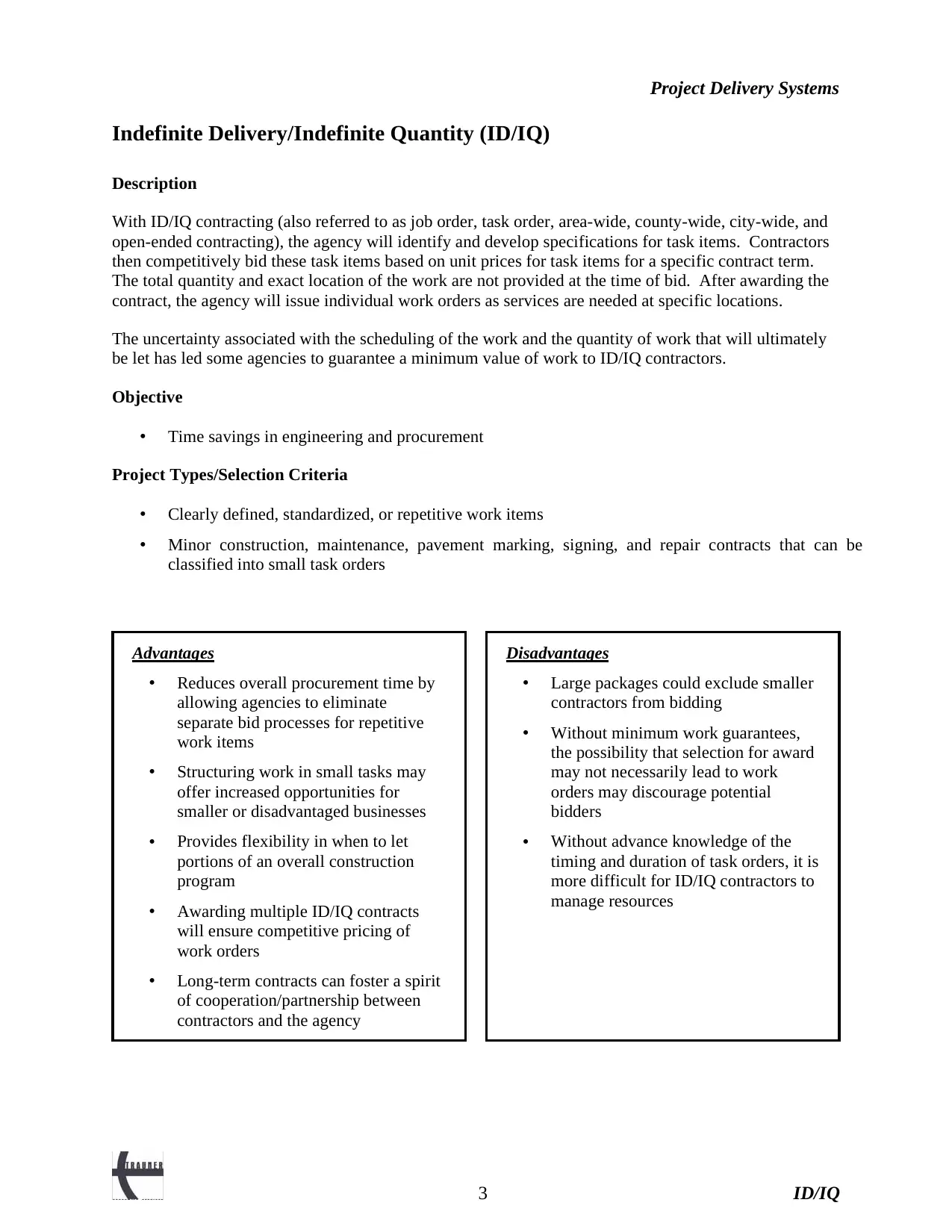
Project Delivery Systems
Indefinite Delivery/Indefinite Quantity (ID/IQ)
Description
With ID/IQ contracting (also referred to as job order, task order, area-wide, county-wide, city-wide, and
open-ended contracting), the agency will identify and develop specifications for task items. Contractors
then competitively bid these task items based on unit prices for task items for a specific contract term.
The total quantity and exact location of the work are not provided at the time of bid. After awarding the
contract, the agency will issue individual work orders as services are needed at specific locations.
The uncertainty associated with the scheduling of the work and the quantity of work that will ultimately
be let has led some agencies to guarantee a minimum value of work to ID/IQ contractors.
Objective
• Time savings in engineering and procurement
Project Types/Selection Criteria
• Clearly defined, standardized, or repetitive work items
• Minor construction, maintenance, pavement marking, signing, and repair contracts that can be
classified into small task orders
Advantages Disadvantages
• Reduces overall procurement time by
allowing agencies to eliminate
separate bid processes for repetitive
work items
• Structuring work in small tasks may
offer increased opportunities for
smaller or disadvantaged businesses
• Provides flexibility in when to let
portions of an overall construction
program
• Awarding multiple ID/IQ contracts
will ensure competitive pricing of
work orders
• Long-term contracts can foster a spirit
of cooperation/partnership between
contractors and the agency
• Large packages could exclude smaller
contractors from bidding
• Without minimum work guarantees,
the possibility that selection for award
may not necessarily lead to work
orders may discourage potential
bidders
• Without advance knowledge of the
timing and duration of task orders, it is
more difficult for ID/IQ contractors to
manage resources
3 ID/IQ
Indefinite Delivery/Indefinite Quantity (ID/IQ)
Description
With ID/IQ contracting (also referred to as job order, task order, area-wide, county-wide, city-wide, and
open-ended contracting), the agency will identify and develop specifications for task items. Contractors
then competitively bid these task items based on unit prices for task items for a specific contract term.
The total quantity and exact location of the work are not provided at the time of bid. After awarding the
contract, the agency will issue individual work orders as services are needed at specific locations.
The uncertainty associated with the scheduling of the work and the quantity of work that will ultimately
be let has led some agencies to guarantee a minimum value of work to ID/IQ contractors.
Objective
• Time savings in engineering and procurement
Project Types/Selection Criteria
• Clearly defined, standardized, or repetitive work items
• Minor construction, maintenance, pavement marking, signing, and repair contracts that can be
classified into small task orders
Advantages Disadvantages
• Reduces overall procurement time by
allowing agencies to eliminate
separate bid processes for repetitive
work items
• Structuring work in small tasks may
offer increased opportunities for
smaller or disadvantaged businesses
• Provides flexibility in when to let
portions of an overall construction
program
• Awarding multiple ID/IQ contracts
will ensure competitive pricing of
work orders
• Long-term contracts can foster a spirit
of cooperation/partnership between
contractors and the agency
• Large packages could exclude smaller
contractors from bidding
• Without minimum work guarantees,
the possibility that selection for award
may not necessarily lead to work
orders may discourage potential
bidders
• Without advance knowledge of the
timing and duration of task orders, it is
more difficult for ID/IQ contractors to
manage resources
3 ID/IQ
Paraphrase This Document
Need a fresh take? Get an instant paraphrase of this document with our AI Paraphraser
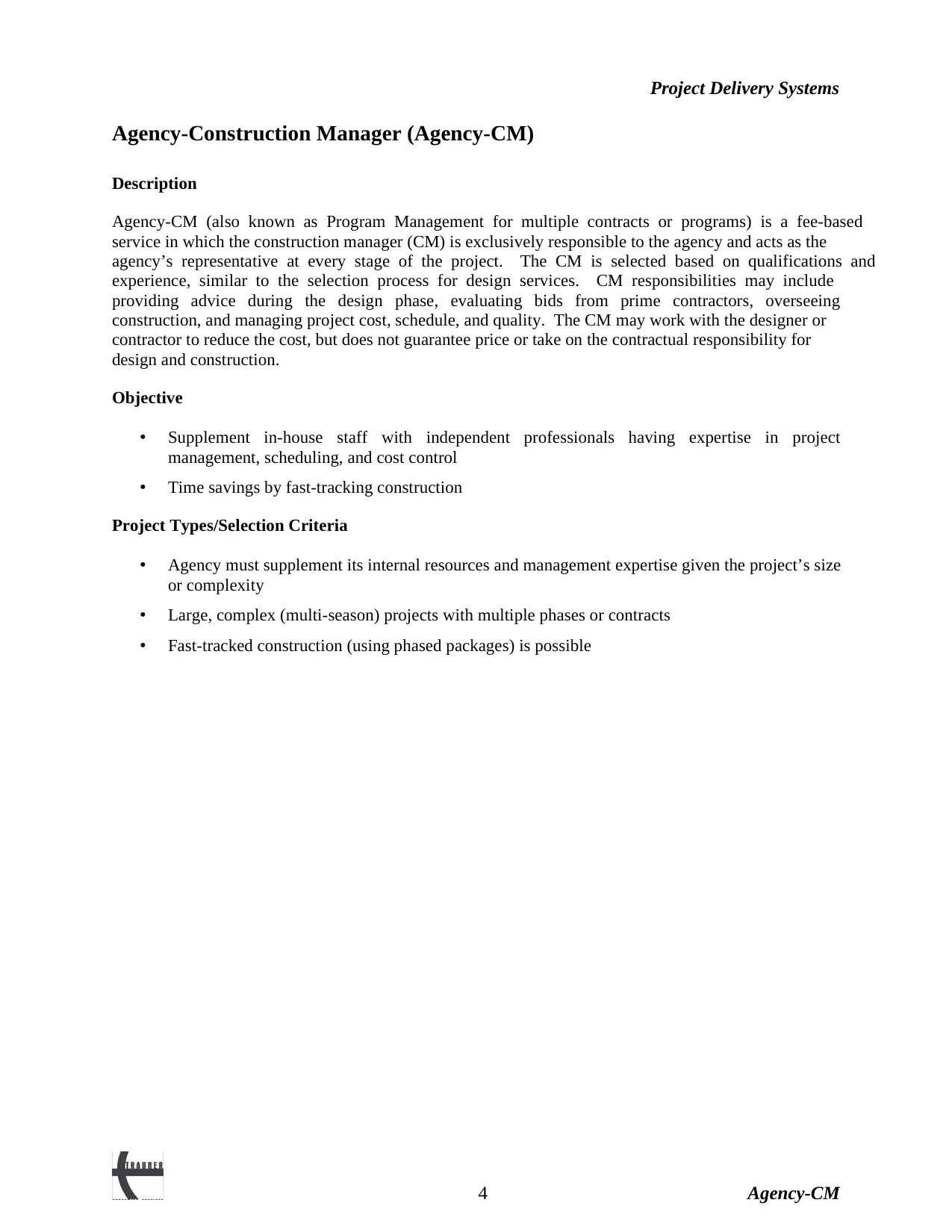
Project Delivery Systems
Agency-Construction Manager (Agency-CM)
Description
Agency-CM (also known as Program Management for multiple contracts or programs) is a fee-based
service in which the construction manager (CM) is exclusively responsible to the agency and acts as the
agency’s representative at every stage of the project. The CM is selected based on qualifications and
experience, similar to the selection process for design services. CM responsibilities may include
providing advice during the design phase, evaluating bids from prime contractors, overseeing
construction, and managing project cost, schedule, and quality. The CM may work with the designer or
contractor to reduce the cost, but does not guarantee price or take on the contractual responsibility for
design and construction.
Objective
• Supplement in-house staff with independent professionals having expertise in project
management, scheduling, and cost control
• Time savings by fast-tracking construction
Project Types/Selection Criteria
• Agency must supplement its internal resources and management expertise given the project’s size
or complexity
• Large, complex (multi-season) projects with multiple phases or contracts
• Fast-tracked construction (using phased packages) is possible
4 Agency-CM
Agency-Construction Manager (Agency-CM)
Description
Agency-CM (also known as Program Management for multiple contracts or programs) is a fee-based
service in which the construction manager (CM) is exclusively responsible to the agency and acts as the
agency’s representative at every stage of the project. The CM is selected based on qualifications and
experience, similar to the selection process for design services. CM responsibilities may include
providing advice during the design phase, evaluating bids from prime contractors, overseeing
construction, and managing project cost, schedule, and quality. The CM may work with the designer or
contractor to reduce the cost, but does not guarantee price or take on the contractual responsibility for
design and construction.
Objective
• Supplement in-house staff with independent professionals having expertise in project
management, scheduling, and cost control
• Time savings by fast-tracking construction
Project Types/Selection Criteria
• Agency must supplement its internal resources and management expertise given the project’s size
or complexity
• Large, complex (multi-season) projects with multiple phases or contracts
• Fast-tracked construction (using phased packages) is possible
4 Agency-CM
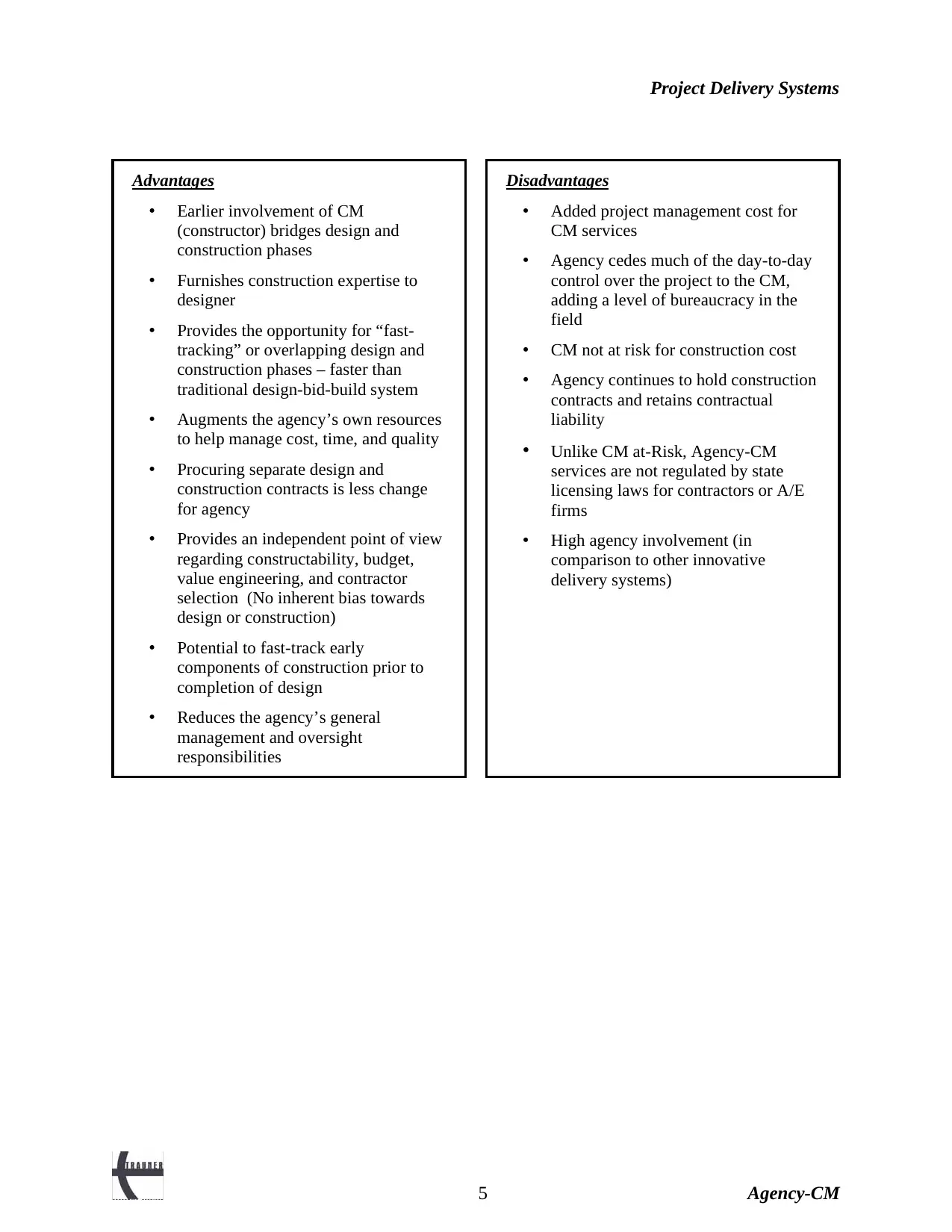
Project Delivery Systems
Advantages Disadvantages
• Earlier involvement of CM
(constructor) bridges design and
construction phases
• Furnishes construction expertise to
designer
• Provides the opportunity for “fast-
tracking” or overlapping design and
construction phases – faster than
traditional design-bid-build system
• Augments the agency’s own resources
to help manage cost, time, and quality
• Procuring separate design and
construction contracts is less change
for agency
• Provides an independent point of view
regarding constructability, budget,
value engineering, and contractor
selection (No inherent bias towards
design or construction)
• Potential to fast-track early
components of construction prior to
completion of design
• Reduces the agency’s general
management and oversight
responsibilities
• Added project management cost for
CM services
• Agency cedes much of the day-to-day
control over the project to the CM,
adding a level of bureaucracy in the
field
• CM not at risk for construction cost
• Agency continues to hold construction
contracts and retains contractual
liability
• Unlike CM at-Risk, Agency-CM
services are not regulated by state
licensing laws for contractors or A/E
firms
• High agency involvement (in
comparison to other innovative
delivery systems)
5 Agency-CM
Advantages Disadvantages
• Earlier involvement of CM
(constructor) bridges design and
construction phases
• Furnishes construction expertise to
designer
• Provides the opportunity for “fast-
tracking” or overlapping design and
construction phases – faster than
traditional design-bid-build system
• Augments the agency’s own resources
to help manage cost, time, and quality
• Procuring separate design and
construction contracts is less change
for agency
• Provides an independent point of view
regarding constructability, budget,
value engineering, and contractor
selection (No inherent bias towards
design or construction)
• Potential to fast-track early
components of construction prior to
completion of design
• Reduces the agency’s general
management and oversight
responsibilities
• Added project management cost for
CM services
• Agency cedes much of the day-to-day
control over the project to the CM,
adding a level of bureaucracy in the
field
• CM not at risk for construction cost
• Agency continues to hold construction
contracts and retains contractual
liability
• Unlike CM at-Risk, Agency-CM
services are not regulated by state
licensing laws for contractors or A/E
firms
• High agency involvement (in
comparison to other innovative
delivery systems)
5 Agency-CM
⊘ This is a preview!⊘
Do you want full access?
Subscribe today to unlock all pages.

Trusted by 1+ million students worldwide
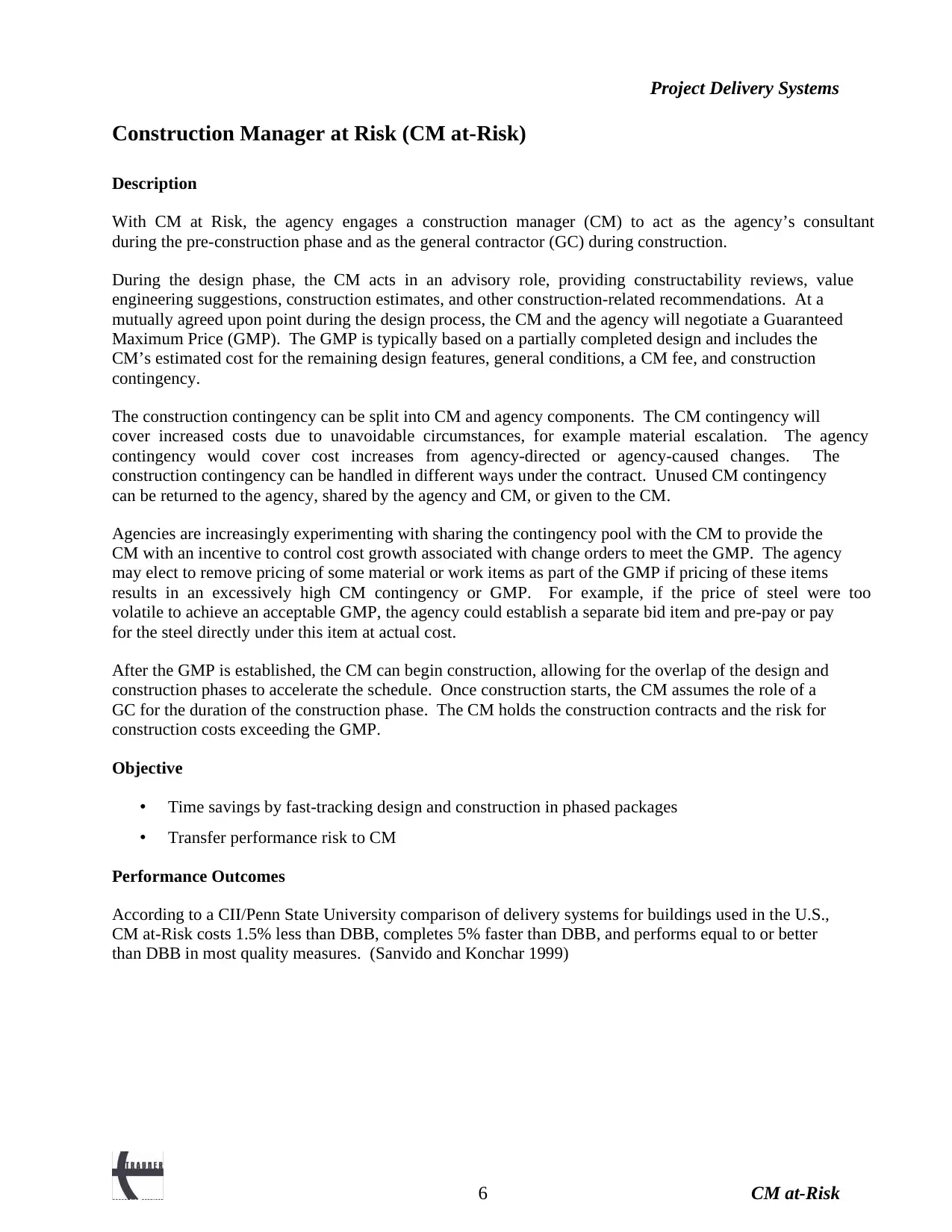
Project Delivery Systems
Construction Manager at Risk (CM at-Risk)
Description
With CM at Risk, the agency engages a construction manager (CM) to act as the agency’s consultant
during the pre-construction phase and as the general contractor (GC) during construction.
During the design phase, the CM acts in an advisory role, providing constructability reviews, value
engineering suggestions, construction estimates, and other construction-related recommendations. At a
mutually agreed upon point during the design process, the CM and the agency will negotiate a Guaranteed
Maximum Price (GMP). The GMP is typically based on a partially completed design and includes the
CM’s estimated cost for the remaining design features, general conditions, a CM fee, and construction
contingency.
The construction contingency can be split into CM and agency components. The CM contingency will
cover increased costs due to unavoidable circumstances, for example material escalation. The agency
contingency would cover cost increases from agency-directed or agency-caused changes. The
construction contingency can be handled in different ways under the contract. Unused CM contingency
can be returned to the agency, shared by the agency and CM, or given to the CM.
Agencies are increasingly experimenting with sharing the contingency pool with the CM to provide the
CM with an incentive to control cost growth associated with change orders to meet the GMP. The agency
may elect to remove pricing of some material or work items as part of the GMP if pricing of these items
results in an excessively high CM contingency or GMP. For example, if the price of steel were too
volatile to achieve an acceptable GMP, the agency could establish a separate bid item and pre-pay or pay
for the steel directly under this item at actual cost.
After the GMP is established, the CM can begin construction, allowing for the overlap of the design and
construction phases to accelerate the schedule. Once construction starts, the CM assumes the role of a
GC for the duration of the construction phase. The CM holds the construction contracts and the risk for
construction costs exceeding the GMP.
Objective
• Time savings by fast-tracking design and construction in phased packages
• Transfer performance risk to CM
Performance Outcomes
According to a CII/Penn State University comparison of delivery systems for buildings used in the U.S.,
CM at-Risk costs 1.5% less than DBB, completes 5% faster than DBB, and performs equal to or better
than DBB in most quality measures. (Sanvido and Konchar 1999)
6 CM at-Risk
Construction Manager at Risk (CM at-Risk)
Description
With CM at Risk, the agency engages a construction manager (CM) to act as the agency’s consultant
during the pre-construction phase and as the general contractor (GC) during construction.
During the design phase, the CM acts in an advisory role, providing constructability reviews, value
engineering suggestions, construction estimates, and other construction-related recommendations. At a
mutually agreed upon point during the design process, the CM and the agency will negotiate a Guaranteed
Maximum Price (GMP). The GMP is typically based on a partially completed design and includes the
CM’s estimated cost for the remaining design features, general conditions, a CM fee, and construction
contingency.
The construction contingency can be split into CM and agency components. The CM contingency will
cover increased costs due to unavoidable circumstances, for example material escalation. The agency
contingency would cover cost increases from agency-directed or agency-caused changes. The
construction contingency can be handled in different ways under the contract. Unused CM contingency
can be returned to the agency, shared by the agency and CM, or given to the CM.
Agencies are increasingly experimenting with sharing the contingency pool with the CM to provide the
CM with an incentive to control cost growth associated with change orders to meet the GMP. The agency
may elect to remove pricing of some material or work items as part of the GMP if pricing of these items
results in an excessively high CM contingency or GMP. For example, if the price of steel were too
volatile to achieve an acceptable GMP, the agency could establish a separate bid item and pre-pay or pay
for the steel directly under this item at actual cost.
After the GMP is established, the CM can begin construction, allowing for the overlap of the design and
construction phases to accelerate the schedule. Once construction starts, the CM assumes the role of a
GC for the duration of the construction phase. The CM holds the construction contracts and the risk for
construction costs exceeding the GMP.
Objective
• Time savings by fast-tracking design and construction in phased packages
• Transfer performance risk to CM
Performance Outcomes
According to a CII/Penn State University comparison of delivery systems for buildings used in the U.S.,
CM at-Risk costs 1.5% less than DBB, completes 5% faster than DBB, and performs equal to or better
than DBB in most quality measures. (Sanvido and Konchar 1999)
6 CM at-Risk
Paraphrase This Document
Need a fresh take? Get an instant paraphrase of this document with our AI Paraphraser
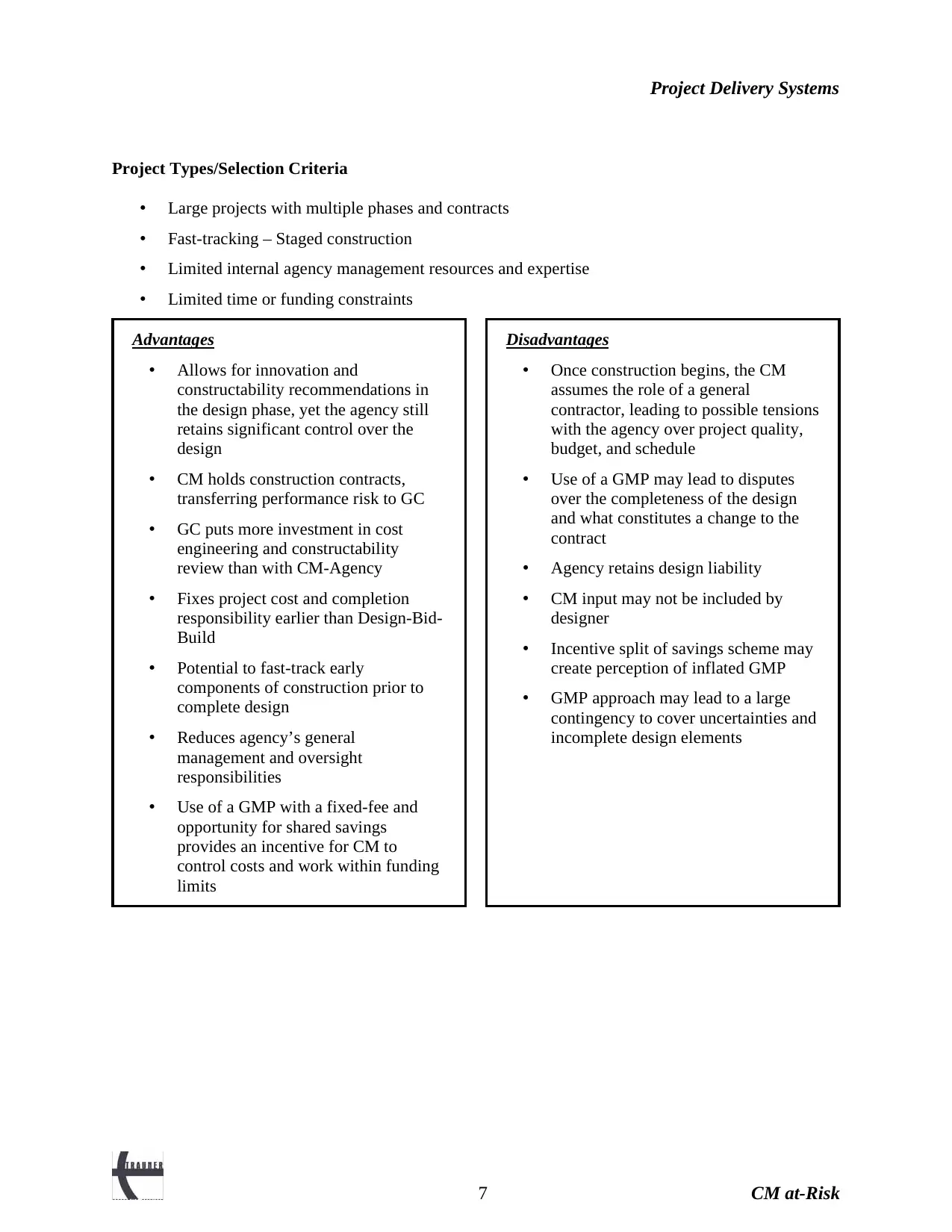
Project Delivery Systems
Project Types/Selection Criteria
• Large projects with multiple phases and contracts
• Fast-tracking – Staged construction
• Limited internal agency management resources and expertise
• Limited time or funding constraints
Advantages Disadvantages
• Allows for innovation and
constructability recommendations in
the design phase, yet the agency still
retains significant control over the
design
• CM holds construction contracts,
transferring performance risk to GC
• GC puts more investment in cost
engineering and constructability
review than with CM-Agency
• Fixes project cost and completion
responsibility earlier than Design-Bid-
Build
• Potential to fast-track early
components of construction prior to
complete design
• Reduces agency’s general
management and oversight
responsibilities
• Use of a GMP with a fixed-fee and
opportunity for shared savings
provides an incentive for CM to
control costs and work within funding
limits
• Once construction begins, the CM
assumes the role of a general
contractor, leading to possible tensions
with the agency over project quality,
budget, and schedule
• Use of a GMP may lead to disputes
over the completeness of the design
and what constitutes a change to the
contract
• Agency retains design liability
• CM input may not be included by
designer
• Incentive split of savings scheme may
create perception of inflated GMP
• GMP approach may lead to a large
contingency to cover uncertainties and
incomplete design elements
7 CM at-Risk
Project Types/Selection Criteria
• Large projects with multiple phases and contracts
• Fast-tracking – Staged construction
• Limited internal agency management resources and expertise
• Limited time or funding constraints
Advantages Disadvantages
• Allows for innovation and
constructability recommendations in
the design phase, yet the agency still
retains significant control over the
design
• CM holds construction contracts,
transferring performance risk to GC
• GC puts more investment in cost
engineering and constructability
review than with CM-Agency
• Fixes project cost and completion
responsibility earlier than Design-Bid-
Build
• Potential to fast-track early
components of construction prior to
complete design
• Reduces agency’s general
management and oversight
responsibilities
• Use of a GMP with a fixed-fee and
opportunity for shared savings
provides an incentive for CM to
control costs and work within funding
limits
• Once construction begins, the CM
assumes the role of a general
contractor, leading to possible tensions
with the agency over project quality,
budget, and schedule
• Use of a GMP may lead to disputes
over the completeness of the design
and what constitutes a change to the
contract
• Agency retains design liability
• CM input may not be included by
designer
• Incentive split of savings scheme may
create perception of inflated GMP
• GMP approach may lead to a large
contingency to cover uncertainties and
incomplete design elements
7 CM at-Risk
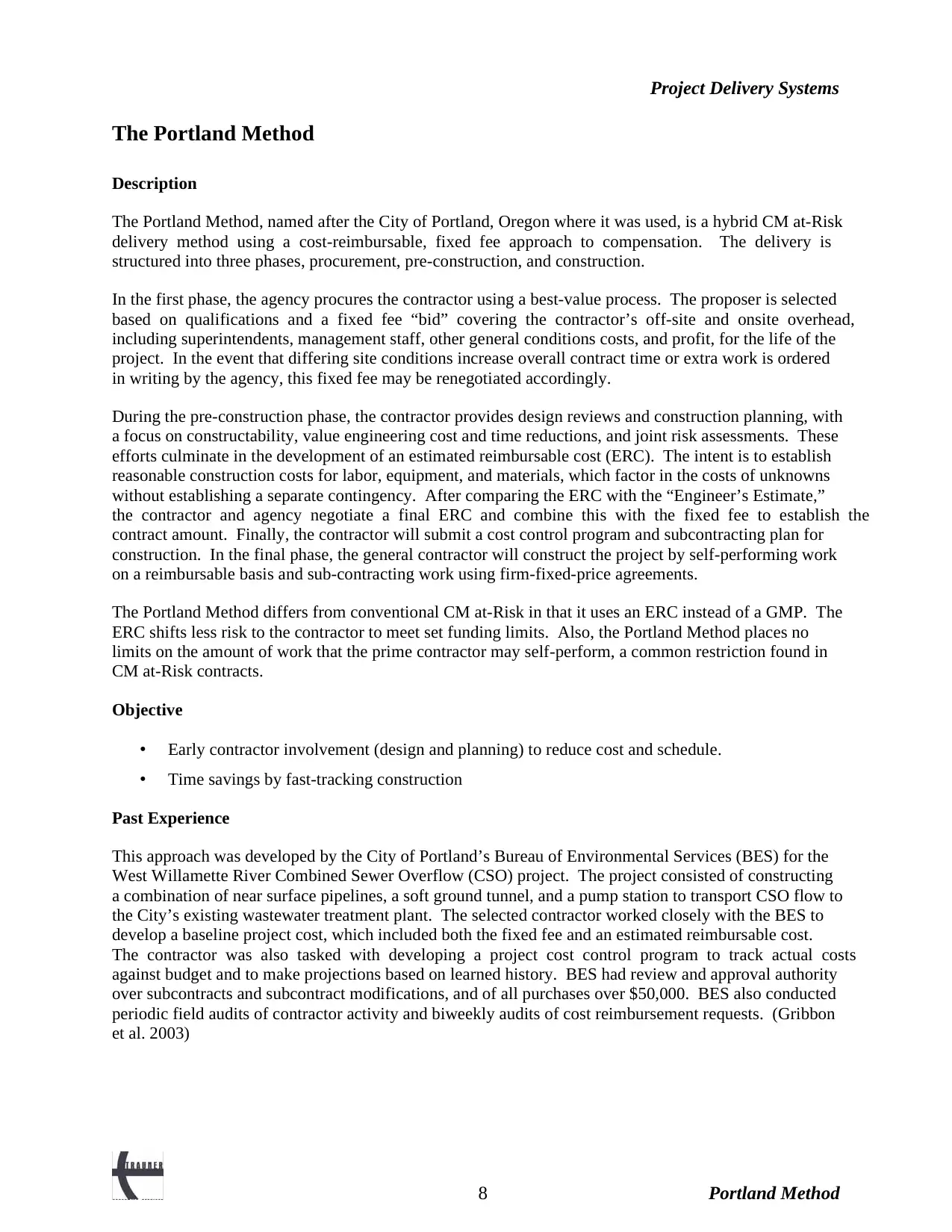
Project Delivery Systems
The Portland Method
Description
The Portland Method, named after the City of Portland, Oregon where it was used, is a hybrid CM at-Risk
delivery method using a cost-reimbursable, fixed fee approach to compensation. The delivery is
structured into three phases, procurement, pre-construction, and construction.
In the first phase, the agency procures the contractor using a best-value process. The proposer is selected
based on qualifications and a fixed fee “bid” covering the contractor’s off-site and onsite overhead,
including superintendents, management staff, other general conditions costs, and profit, for the life of the
project. In the event that differing site conditions increase overall contract time or extra work is ordered
in writing by the agency, this fixed fee may be renegotiated accordingly.
During the pre-construction phase, the contractor provides design reviews and construction planning, with
a focus on constructability, value engineering cost and time reductions, and joint risk assessments. These
efforts culminate in the development of an estimated reimbursable cost (ERC). The intent is to establish
reasonable construction costs for labor, equipment, and materials, which factor in the costs of unknowns
without establishing a separate contingency. After comparing the ERC with the “Engineer’s Estimate,”
the contractor and agency negotiate a final ERC and combine this with the fixed fee to establish the
contract amount. Finally, the contractor will submit a cost control program and subcontracting plan for
construction. In the final phase, the general contractor will construct the project by self-performing work
on a reimbursable basis and sub-contracting work using firm-fixed-price agreements.
The Portland Method differs from conventional CM at-Risk in that it uses an ERC instead of a GMP. The
ERC shifts less risk to the contractor to meet set funding limits. Also, the Portland Method places no
limits on the amount of work that the prime contractor may self-perform, a common restriction found in
CM at-Risk contracts.
Objective
• Early contractor involvement (design and planning) to reduce cost and schedule.
• Time savings by fast-tracking construction
Past Experience
This approach was developed by the City of Portland’s Bureau of Environmental Services (BES) for the
West Willamette River Combined Sewer Overflow (CSO) project. The project consisted of constructing
a combination of near surface pipelines, a soft ground tunnel, and a pump station to transport CSO flow to
the City’s existing wastewater treatment plant. The selected contractor worked closely with the BES to
develop a baseline project cost, which included both the fixed fee and an estimated reimbursable cost.
The contractor was also tasked with developing a project cost control program to track actual costs
against budget and to make projections based on learned history. BES had review and approval authority
over subcontracts and subcontract modifications, and of all purchases over $50,000. BES also conducted
periodic field audits of contractor activity and biweekly audits of cost reimbursement requests. (Gribbon
et al. 2003)
8 Portland Method
The Portland Method
Description
The Portland Method, named after the City of Portland, Oregon where it was used, is a hybrid CM at-Risk
delivery method using a cost-reimbursable, fixed fee approach to compensation. The delivery is
structured into three phases, procurement, pre-construction, and construction.
In the first phase, the agency procures the contractor using a best-value process. The proposer is selected
based on qualifications and a fixed fee “bid” covering the contractor’s off-site and onsite overhead,
including superintendents, management staff, other general conditions costs, and profit, for the life of the
project. In the event that differing site conditions increase overall contract time or extra work is ordered
in writing by the agency, this fixed fee may be renegotiated accordingly.
During the pre-construction phase, the contractor provides design reviews and construction planning, with
a focus on constructability, value engineering cost and time reductions, and joint risk assessments. These
efforts culminate in the development of an estimated reimbursable cost (ERC). The intent is to establish
reasonable construction costs for labor, equipment, and materials, which factor in the costs of unknowns
without establishing a separate contingency. After comparing the ERC with the “Engineer’s Estimate,”
the contractor and agency negotiate a final ERC and combine this with the fixed fee to establish the
contract amount. Finally, the contractor will submit a cost control program and subcontracting plan for
construction. In the final phase, the general contractor will construct the project by self-performing work
on a reimbursable basis and sub-contracting work using firm-fixed-price agreements.
The Portland Method differs from conventional CM at-Risk in that it uses an ERC instead of a GMP. The
ERC shifts less risk to the contractor to meet set funding limits. Also, the Portland Method places no
limits on the amount of work that the prime contractor may self-perform, a common restriction found in
CM at-Risk contracts.
Objective
• Early contractor involvement (design and planning) to reduce cost and schedule.
• Time savings by fast-tracking construction
Past Experience
This approach was developed by the City of Portland’s Bureau of Environmental Services (BES) for the
West Willamette River Combined Sewer Overflow (CSO) project. The project consisted of constructing
a combination of near surface pipelines, a soft ground tunnel, and a pump station to transport CSO flow to
the City’s existing wastewater treatment plant. The selected contractor worked closely with the BES to
develop a baseline project cost, which included both the fixed fee and an estimated reimbursable cost.
The contractor was also tasked with developing a project cost control program to track actual costs
against budget and to make projections based on learned history. BES had review and approval authority
over subcontracts and subcontract modifications, and of all purchases over $50,000. BES also conducted
periodic field audits of contractor activity and biweekly audits of cost reimbursement requests. (Gribbon
et al. 2003)
8 Portland Method
⊘ This is a preview!⊘
Do you want full access?
Subscribe today to unlock all pages.

Trusted by 1+ million students worldwide
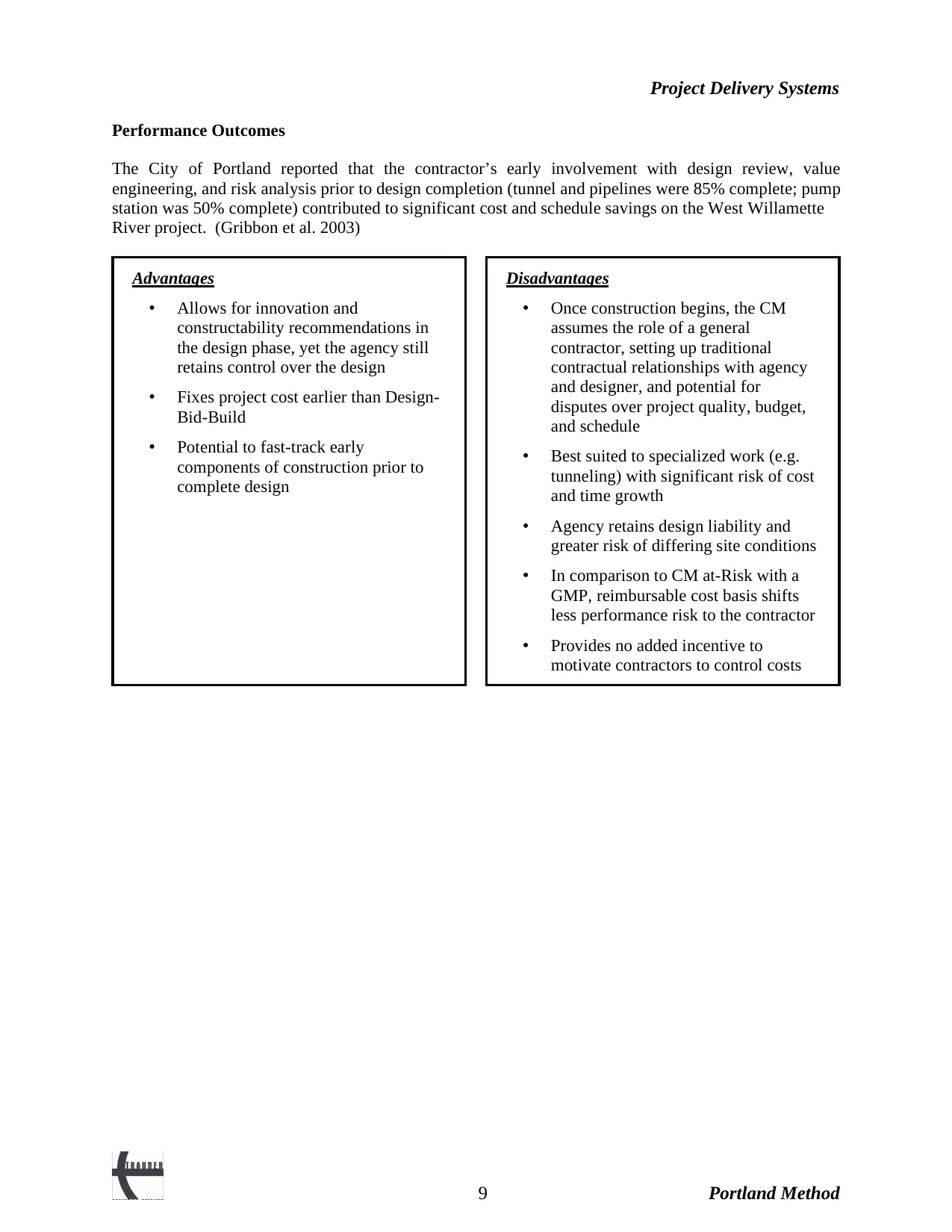
Project Delivery Systems
Performance Outcomes
The City of Portland reported that the contractor’s early involvement with design review, value
engineering, and risk analysis prior to design completion (tunnel and pipelines were 85% complete; pump
station was 50% complete) contributed to significant cost and schedule savings on the West Willamette
River project. (Gribbon et al. 2003)
Advantages Disadvantages
• Allows for innovation and
constructability recommendations in
the design phase, yet the agency still
retains control over the design
• Fixes project cost earlier than Design-
Bid-Build
• Potential to fast-track early
components of construction prior to
complete design
• Once construction begins, the CM
assumes the role of a general
contractor, setting up traditional
contractual relationships with agency
and designer, and potential for
disputes over project quality, budget,
and schedule
• Best suited to specialized work (e.g.
tunneling) with significant risk of cost
and time growth
• Agency retains design liability and
greater risk of differing site conditions
• In comparison to CM at-Risk with a
GMP, reimbursable cost basis shifts
less performance risk to the contractor
• Provides no added incentive to
motivate contractors to control costs
9 Portland Method
Performance Outcomes
The City of Portland reported that the contractor’s early involvement with design review, value
engineering, and risk analysis prior to design completion (tunnel and pipelines were 85% complete; pump
station was 50% complete) contributed to significant cost and schedule savings on the West Willamette
River project. (Gribbon et al. 2003)
Advantages Disadvantages
• Allows for innovation and
constructability recommendations in
the design phase, yet the agency still
retains control over the design
• Fixes project cost earlier than Design-
Bid-Build
• Potential to fast-track early
components of construction prior to
complete design
• Once construction begins, the CM
assumes the role of a general
contractor, setting up traditional
contractual relationships with agency
and designer, and potential for
disputes over project quality, budget,
and schedule
• Best suited to specialized work (e.g.
tunneling) with significant risk of cost
and time growth
• Agency retains design liability and
greater risk of differing site conditions
• In comparison to CM at-Risk with a
GMP, reimbursable cost basis shifts
less performance risk to the contractor
• Provides no added incentive to
motivate contractors to control costs
9 Portland Method
Paraphrase This Document
Need a fresh take? Get an instant paraphrase of this document with our AI Paraphraser
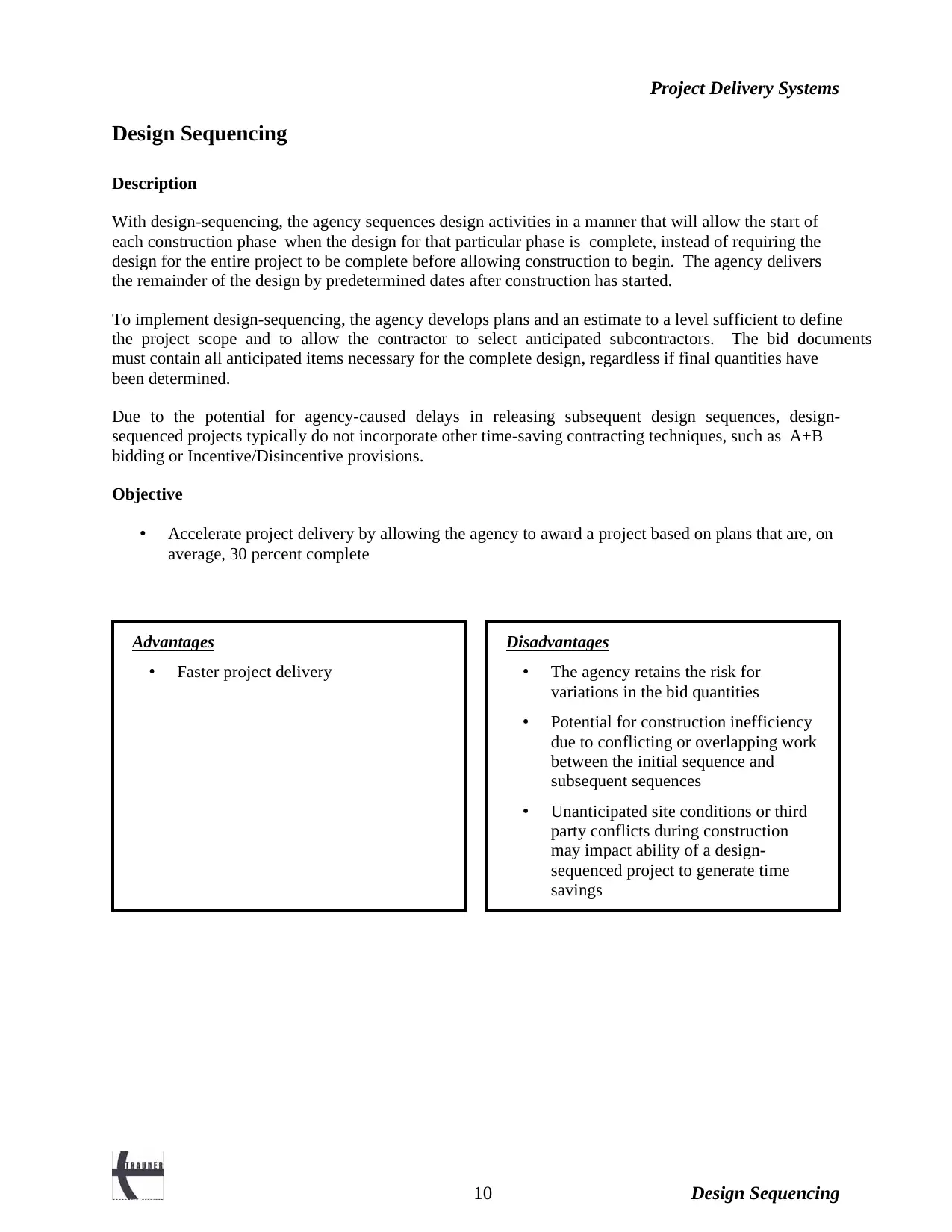
Project Delivery Systems
Design Sequencing
Description
With design-sequencing, the agency sequences design activities in a manner that will allow the start of
each construction phase when the design for that particular phase is complete, instead of requiring the
design for the entire project to be complete before allowing construction to begin. The agency delivers
the remainder of the design by predetermined dates after construction has started.
To implement design-sequencing, the agency develops plans and an estimate to a level sufficient to define
the project scope and to allow the contractor to select anticipated subcontractors. The bid documents
must contain all anticipated items necessary for the complete design, regardless if final quantities have
been determined.
Due to the potential for agency-caused delays in releasing subsequent design sequences, design-
sequenced projects typically do not incorporate other time-saving contracting techniques, such as A+B
bidding or Incentive/Disincentive provisions.
Objective
• Accelerate project delivery by allowing the agency to award a project based on plans that are, on
average, 30 percent complete
Advantages Disadvantages
• Faster project delivery • The agency retains the risk for
variations in the bid quantities
• Potential for construction inefficiency
due to conflicting or overlapping work
between the initial sequence and
subsequent sequences
• Unanticipated site conditions or third
party conflicts during construction
may impact ability of a design-
sequenced project to generate time
savings
10 Design Sequencing
Design Sequencing
Description
With design-sequencing, the agency sequences design activities in a manner that will allow the start of
each construction phase when the design for that particular phase is complete, instead of requiring the
design for the entire project to be complete before allowing construction to begin. The agency delivers
the remainder of the design by predetermined dates after construction has started.
To implement design-sequencing, the agency develops plans and an estimate to a level sufficient to define
the project scope and to allow the contractor to select anticipated subcontractors. The bid documents
must contain all anticipated items necessary for the complete design, regardless if final quantities have
been determined.
Due to the potential for agency-caused delays in releasing subsequent design sequences, design-
sequenced projects typically do not incorporate other time-saving contracting techniques, such as A+B
bidding or Incentive/Disincentive provisions.
Objective
• Accelerate project delivery by allowing the agency to award a project based on plans that are, on
average, 30 percent complete
Advantages Disadvantages
• Faster project delivery • The agency retains the risk for
variations in the bid quantities
• Potential for construction inefficiency
due to conflicting or overlapping work
between the initial sequence and
subsequent sequences
• Unanticipated site conditions or third
party conflicts during construction
may impact ability of a design-
sequenced project to generate time
savings
10 Design Sequencing
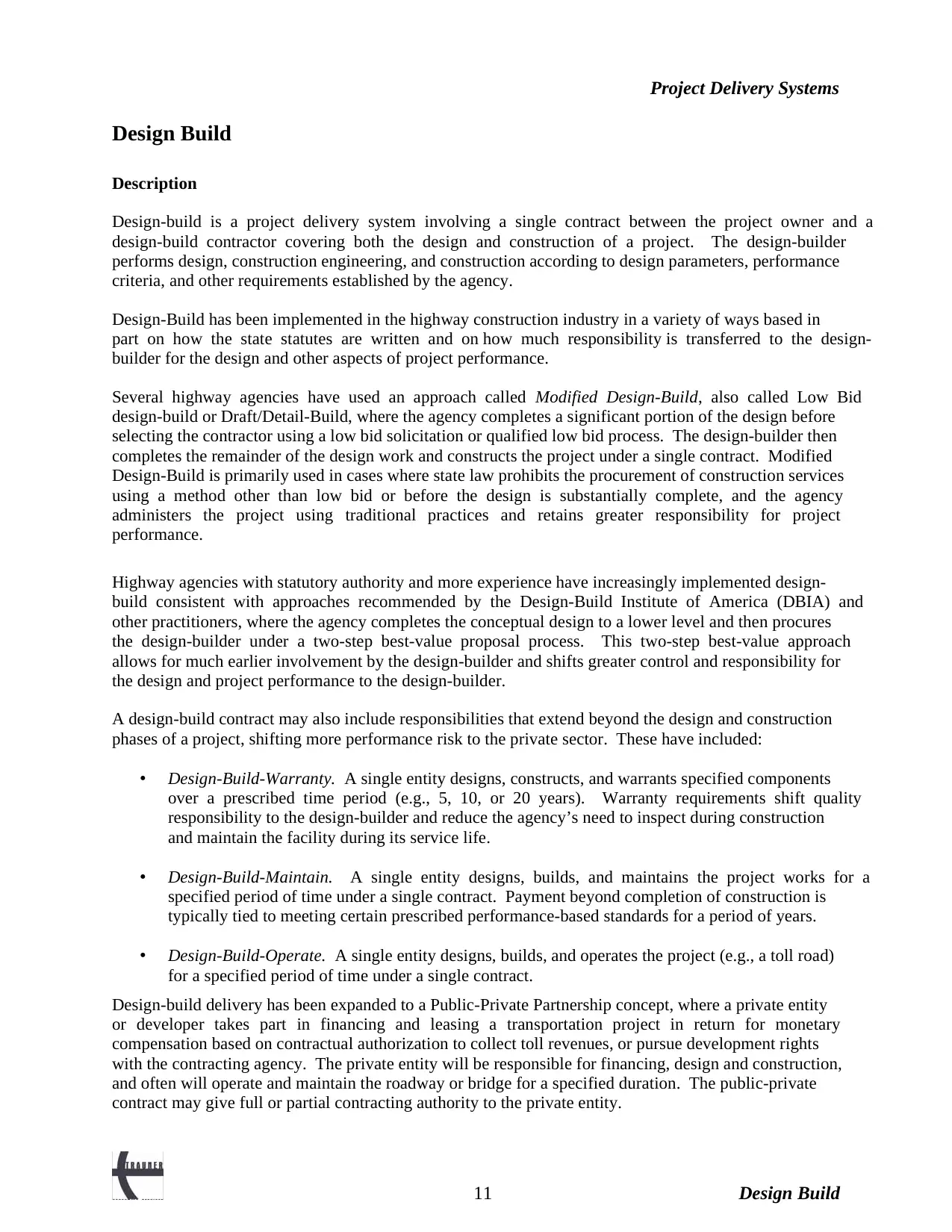
Project Delivery Systems
Design Build
Description
Design-build is a project delivery system involving a single contract between the project owner and a
design-build contractor covering both the design and construction of a project. The design-builder
performs design, construction engineering, and construction according to design parameters, performance
criteria, and other requirements established by the agency.
Design-Build has been implemented in the highway construction industry in a variety of ways based in
part on how the state statutes are written and on how much responsibility is transferred to the design-
builder for the design and other aspects of project performance.
Several highway agencies have used an approach called Modified Design-Build, also called Low Bid
design-build or Draft/Detail-Build, where the agency completes a significant portion of the design before
selecting the contractor using a low bid solicitation or qualified low bid process. The design-builder then
completes the remainder of the design work and constructs the project under a single contract. Modified
Design-Build is primarily used in cases where state law prohibits the procurement of construction services
using a method other than low bid or before the design is substantially complete, and the agency
administers the project using traditional practices and retains greater responsibility for project
performance.
Highway agencies with statutory authority and more experience have increasingly implemented design-
build consistent with approaches recommended by the Design-Build Institute of America (DBIA) and
other practitioners, where the agency completes the conceptual design to a lower level and then procures
the design-builder under a two-step best-value proposal process. This two-step best-value approach
allows for much earlier involvement by the design-builder and shifts greater control and responsibility for
the design and project performance to the design-builder.
A design-build contract may also include responsibilities that extend beyond the design and construction
phases of a project, shifting more performance risk to the private sector. These have included:
• Design-Build-Warranty. A single entity designs, constructs, and warrants specified components
over a prescribed time period (e.g., 5, 10, or 20 years). Warranty requirements shift quality
responsibility to the design-builder and reduce the agency’s need to inspect during construction
and maintain the facility during its service life.
• Design-Build-Maintain. A single entity designs, builds, and maintains the project works for a
specified period of time under a single contract. Payment beyond completion of construction is
typically tied to meeting certain prescribed performance-based standards for a period of years.
• Design-Build-Operate. A single entity designs, builds, and operates the project (e.g., a toll road)
for a specified period of time under a single contract.
Design-build delivery has been expanded to a Public-Private Partnership concept, where a private entity
or developer takes part in financing and leasing a transportation project in return for monetary
compensation based on contractual authorization to collect toll revenues, or pursue development rights
with the contracting agency. The private entity will be responsible for financing, design and construction,
and often will operate and maintain the roadway or bridge for a specified duration. The public-private
contract may give full or partial contracting authority to the private entity.
11 Design Build
Design Build
Description
Design-build is a project delivery system involving a single contract between the project owner and a
design-build contractor covering both the design and construction of a project. The design-builder
performs design, construction engineering, and construction according to design parameters, performance
criteria, and other requirements established by the agency.
Design-Build has been implemented in the highway construction industry in a variety of ways based in
part on how the state statutes are written and on how much responsibility is transferred to the design-
builder for the design and other aspects of project performance.
Several highway agencies have used an approach called Modified Design-Build, also called Low Bid
design-build or Draft/Detail-Build, where the agency completes a significant portion of the design before
selecting the contractor using a low bid solicitation or qualified low bid process. The design-builder then
completes the remainder of the design work and constructs the project under a single contract. Modified
Design-Build is primarily used in cases where state law prohibits the procurement of construction services
using a method other than low bid or before the design is substantially complete, and the agency
administers the project using traditional practices and retains greater responsibility for project
performance.
Highway agencies with statutory authority and more experience have increasingly implemented design-
build consistent with approaches recommended by the Design-Build Institute of America (DBIA) and
other practitioners, where the agency completes the conceptual design to a lower level and then procures
the design-builder under a two-step best-value proposal process. This two-step best-value approach
allows for much earlier involvement by the design-builder and shifts greater control and responsibility for
the design and project performance to the design-builder.
A design-build contract may also include responsibilities that extend beyond the design and construction
phases of a project, shifting more performance risk to the private sector. These have included:
• Design-Build-Warranty. A single entity designs, constructs, and warrants specified components
over a prescribed time period (e.g., 5, 10, or 20 years). Warranty requirements shift quality
responsibility to the design-builder and reduce the agency’s need to inspect during construction
and maintain the facility during its service life.
• Design-Build-Maintain. A single entity designs, builds, and maintains the project works for a
specified period of time under a single contract. Payment beyond completion of construction is
typically tied to meeting certain prescribed performance-based standards for a period of years.
• Design-Build-Operate. A single entity designs, builds, and operates the project (e.g., a toll road)
for a specified period of time under a single contract.
Design-build delivery has been expanded to a Public-Private Partnership concept, where a private entity
or developer takes part in financing and leasing a transportation project in return for monetary
compensation based on contractual authorization to collect toll revenues, or pursue development rights
with the contracting agency. The private entity will be responsible for financing, design and construction,
and often will operate and maintain the roadway or bridge for a specified duration. The public-private
contract may give full or partial contracting authority to the private entity.
11 Design Build
⊘ This is a preview!⊘
Do you want full access?
Subscribe today to unlock all pages.

Trusted by 1+ million students worldwide
1 out of 35
Related Documents
Your All-in-One AI-Powered Toolkit for Academic Success.
+13062052269
info@desklib.com
Available 24*7 on WhatsApp / Email
![[object Object]](/_next/static/media/star-bottom.7253800d.svg)
Unlock your academic potential
Copyright © 2020–2025 A2Z Services. All Rights Reserved. Developed and managed by ZUCOL.



